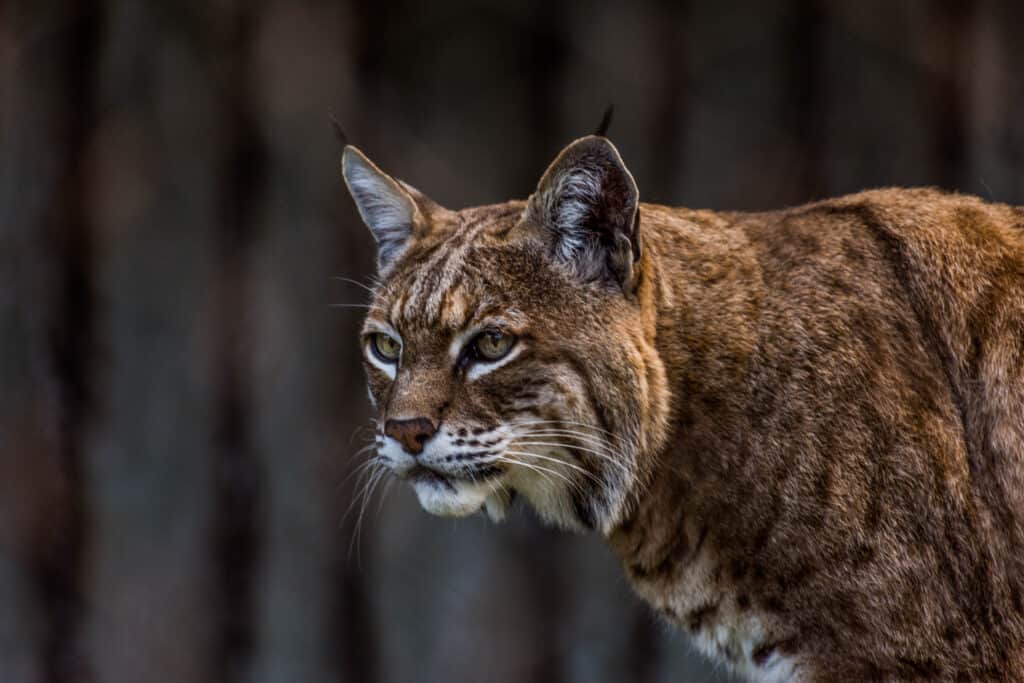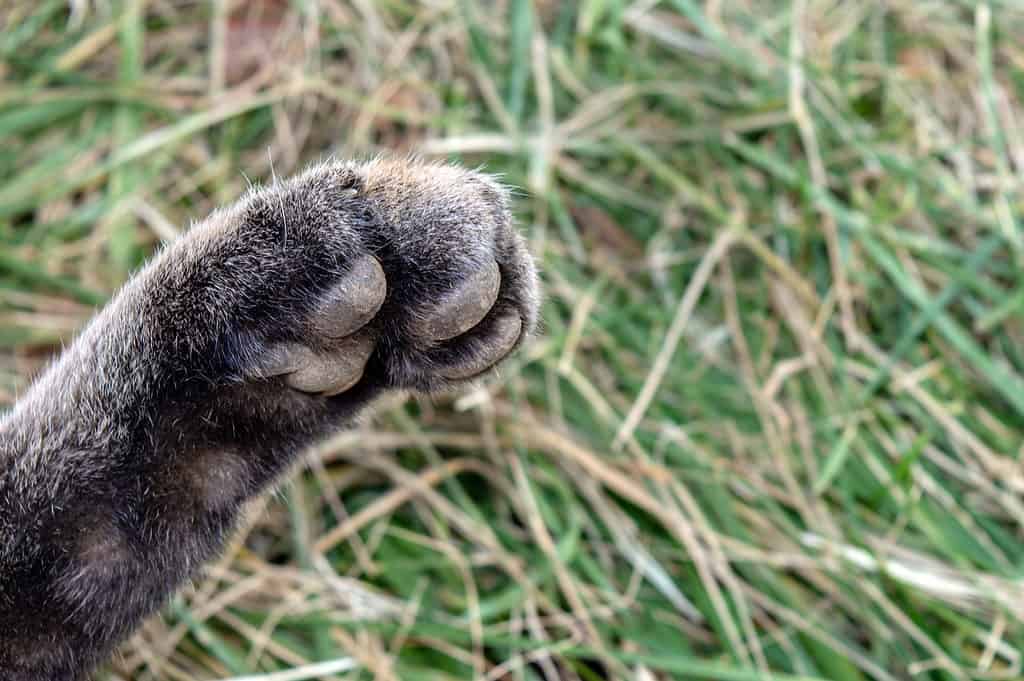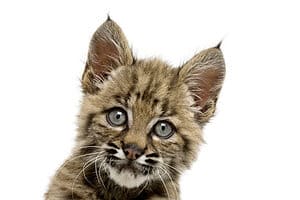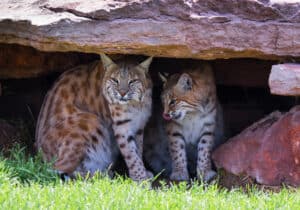When you are in the wild, it is important to be knowledgeable of the animals you are sharing the area with. Not only can it be helpful when looking for creatures in their natural habitats, but it can be necessary to ensure you remain safe in their presence. One skill that can help prepare you to take on the great outdoors and all of its inhabitants is identifying animal tracks. By recognizing animal tracks, you will know whose home you are encroaching on and proceed safely. Tracking animals is also useful for hunting. This article is a complete guide for identifying bobcat tracks. You will learn what bobcats are, where you might find them, and what their tracks look like in different environmental conditions. Read on for everything you need to know to identify tracks in bobcat territory.
| Characteristics | Description |
|---|---|
| Size | 1-3 inches across |
| Features | 4 asymmetric toe pads 1 palm pad |
| Shape | Round pawprint |
| Claw Impressions | Absent |

Bobcats are medium-sized wild cats.
©Victor Arita/Shutterstock.com
Animal Background
Description
The bobcat, Lynx rufus, is a medium size species of wild cat. It belongs to the same genus as the Canada lynx, Iberian lynx, and Eurasian lynx. Bobcats resemble other lynxes but are the smallest in the genus. Their fur coat is primarily tan with black markings, and they have distinctive black bars on their forelimbs and tail. Their tail is a short stub measuring between 3 ½ and 7 inches. Bobcats have black tufts on the tops of their ears and they have yellow eyes.

Bobcats have distinct black bar markings on their forelimbs and stubby tails.
©Don DeBold from San Jose, CA, USA, CC BY-SA 2.0, via Wikimedia Commons – License
Although they are the smallest of the lynxes, bobcats are substantial in size. An adult bobcat is 18 to 50 inches long from its head to the base of its tail. Its height at the shoulder is 18 inches on average. A fully grown male bobcat can weigh up to 40 pounds but is approximately 21 pounds on average. Females are smaller with an average weight of 15 pounds. The largest bobcat on record was a male found in New Hampshire in 1927 weighing 51 pounds!
Distribution
Bobcats only live in North America. They inhabit a wide area across Canada, the United States, and parts of Mexico. There are fewer bobcats in Canada than in the United States because of snow depth and competition with the Canada lynx. Canada lynxes have larger feet than bobcats which allow them to distribute their weight across a greater surface area when they are walking on snow and ice. This adaptation is analogous to a human putting on snowshoes. Bobcats have been reported in every state in the contiguous U.S. except for Delaware.

The closely related Canada lynx has larger pawprints than bobcats.
©Felineus/Shutterstock.com
Bobcats are extremely versatile. They live in many habitats, including deciduous and coniferous forests, mountainous regions, deserts, swamplands, and human-inhabited areas. They do not live in urban areas but can inhabit rural and suburban ones.
Bobcat Tracks
Paw Morphology

A bobcat paw has 4 toe pads and 1 palm pad.
©Diane079F/Shutterstock.com
Bobcats have 5 toes on their front feet and 4 toes on their back feet. The fifth toe on the front paws, however, is positioned high on the backside of the leg and would not be visible in their tracks. The other four toes are adjacent at the front of the paw. These toes are larger and have digital pads that are asymmetrical. The center of their paw has a palm pad that is round with two lobes. Bobcats have retractile claws, which means they can be extended or retracted as needed. As a result, their tracks do not include visible impressions from their claws. A bobcat track is very round, especially the front pawprints, and is typically 1 to 3 inches in diameter.
Snow
In the northern or mountainous regions that bobcats inhabit, you may find their tracks in the snow. Bobcats typically do not tread through deep snow so tracks will more likely appear on compact snow. A track in the snow will often make for a clear impression, but in bright areas, the lack of contrast may skew visibility. Impressions in the snow will include the four asymmetrical toe pads and the palm pad.

Bobcats often leave tracks in the snow in their northern and mountainous ranges.
©Sari ONeal/Shutterstock.com
In snowy areas, you can also use local knowledge of coexisting species to help you identify tracks. These regions may be home to Canada lynxes, wolves, coyotes, or other species that leave similar pawprints. Bobcat tracks can be distinguished from Canada lynx tracks because they are much smaller. A bobcat’s pawprint is 1 to 3 inches in diameter whereas a Canada lynx’s track is up to 5 inches across. Bobcat tracks are also distinct from different canine species because they are rounder. Canine pawprints are narrower than bobcat tracks and are a teardrop shape with their toes meeting at a point. You can also often see claw marks in canine pawprints.
Mud
When tracking bobcats, you will most likely find prints in mud or other types of soft ground. Animals often leave clear tracks in the mud because the impression sinks slightly under their weight. They are also clearer than prints in the snow because of color contrast. Bobcats live in forests and swamps where much of the terrain will allow for clear mud tracks.

Bobcat tracks are often the clearest and most easy to identify in the mud.
©Bobcat tracks in the mud/Shutterstock.com
In the mud, bobcat tracks will include the four toe pads and the palm pad. The print will appear rounder than wolf or coyote tracks that may also exist in overlapping territories. In suburban or rural areas, the most likely animal species whose prints can be confused for a bobcat’s is the domestic cat. Domestic cats have pawprints between 1 and 1 ½ inches. While bobcat prints can be up to 3 inches, smaller individuals may have similar size prints to domestic cats. The distinguishing trait will be the round shape of bobcat tracks.
Other
On hard ground, bobcat tracks may be indiscernible. Bobcats do not weigh enough to leave significant tracks on hard dirt or other such surfaces. If the ground isn’t too rigid, small impressions may be made beneath the points of the paw that carry the most weight. The center of the palm pad and the tips of the toe pads may leave faint impressions on hard ground, but the track as a whole will appear smaller than tracks in the mud or snow.
Other Tracking Tips
Scat
If you are tracking a bobcat or trying to identify some unknown prints, other clues in the environment may be helpful. One important source of information to keep an eye out for in the wild is scat. Bobcat excrement can be a valuable tool when tracking these animals and can provide you with much information. If you can identify bobcat scat, then you can more easily identify tracks and you can estimate how recently a bobcat was in the area. If the poop is fresh, the bobcat was likely nearby very recently.
Bobcat scat is cylindrical and is most often brown or black. It closely resembles domestic cat poop but can be slightly larger. One difficulty in identifying bobcat droppings, however, is that they often bury it partially or cover it with leaves and debris, similar to pet cats.
The photo featured at the top of this post is © Laurie E Wilson/Shutterstock.com
Thank you for reading! Have some feedback for us? Contact the AZ Animals editorial team.






